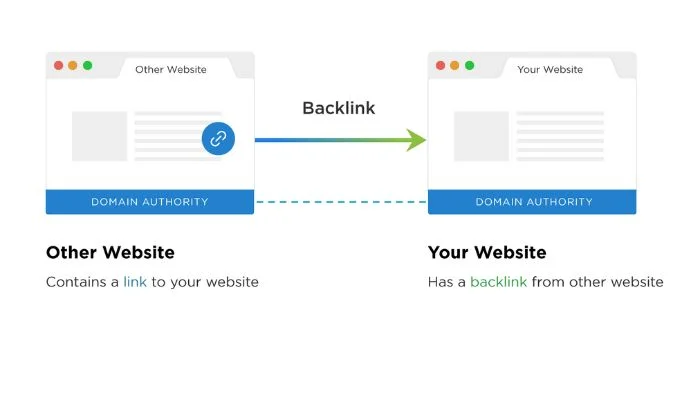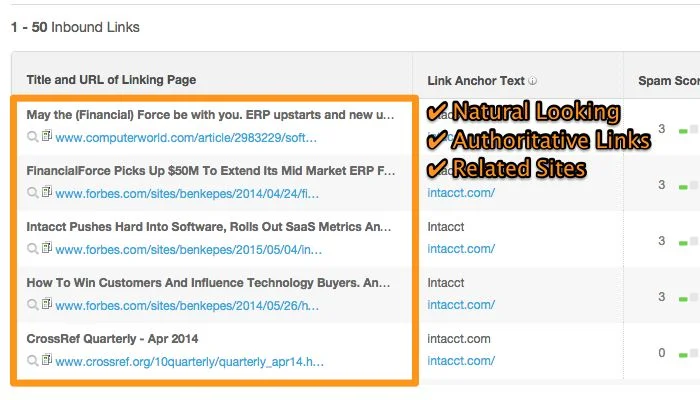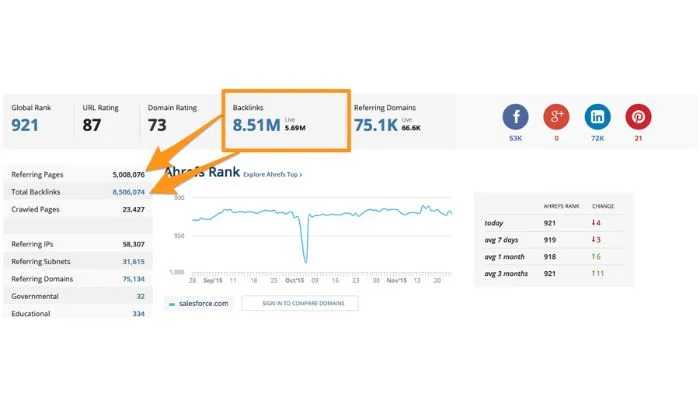Backlink Profile: Discovering the Web of Links

Backlinks are often considered the cornerstone of a successful search engine optimization (SEO) strategy. When it comes to driving organic website traffic, backlinks can often make or break a business's success.
A backlink profile is essentially an overview of all the websites that are linking to your particular site – measuring both quantity and quality.
Analyzing and properly managing backlink profiles is key for SEO growth as they serve as an essential signal in terms of establishing domain credibility and showing how popular a page or website is on the World Wide Web.
This blog will cover everything there is to know about backlink profiles - understanding what elements they contain, analyzing them, building up healthy ones, tracking progress, and much more!
What are Backlinks?

Backlinks are links from other relevant websites that link to a given page on the web. In simpler terms, when someone else refers to your article or website via a link, it's called a backlink. Backlinks can point to any page of the website, including internal pages as well as the homepage.
These external links represent relationships and trust between different sites and will mostly help in SEO efforts by elevating organic search engine ranking.
Search engine crawlers assess these kinds of links to determine which content is most relevant for certain queries, and high-quality backlinks bring relevancy to the ranking equation. The higher the number of quality backlinks connected to specific articles, blogs, etc., the more authoritative they become.
Types of backlinks (dofollow, nofollow)
There are two types of backlinks – dofollow and nofollow. Dofollow backlinks tell search engines that your content is relevant and should be shown in search engine results pages, thereby resulting in improved traffic from viewers who click through the link.
On the other hand, no follow links do not have a carry degree of significance as they don't give any SEO benefits but these attributes nowadays provide potential social proof for the visitors/customers interested in knowing more about a website before sharing personal details on it or investing money with it.
Significance of backlinks in SEO
Backlinks are important in SEO because they are used to measure the importance of websites and support credibility. Backlinks refer to external links pointing from other pages back to your site and confer authority when they come from sources with a high domain or page rank.
A large number of good links coming from reputable websites indicate that you write authoritative content which strengthens the trustworthiness level of your site.
Higher Domain Authority sites also have a higher ability to rank above competitors. As more external sites link back to yours, achieving better visibility and organic reach is an expected outcome for sustainable SEO improvements.
Backlink Profile

A backlink profile is a record of the links that point outwards from any given web page. It captures details about the specific link, such as the referring website, anchor text, and its related ranking power or link juice, among others.
A robust and healthy backlink profile is what fuels positive signals to search engines—helping a website land in higher positions even when it strictly adheres to the rule book sans excessive manipulation.
The strength of information collection in the form of appropriate number with optimal quality interpreted together, determine how well your link power performs over time.
Components of a backlink profile
1. Quantity of backlinks
The number of backlinks to a website is an important component of a backlink profile. Generally, websites with more comparative backlinks from well-established and respected sources demonstrate higher levels of search engine authority than those with fewer links.
That said, it is possible for sites to have artificially inflated numbers that may not necessarily boost organic search engine rankings.
As such, quality matters much more than quantity when assessing relevance and value through a backlink analysis.
When analyzing the number of links in an account's profile, factors such as relevancy to content around domain rating should all be taken into consideration as well in order to prevent any potential issues stemming from low-quality or irrelevant link-building tactics arising.
2. Quality of backlinks
The quality of a backlink profile is an important factor in building long-term success and improving organic search rankings. High-quality backlinks contribute much more value than those from low-quality websites, as search engine algorithms prioritize sites with legitimate authority and trustworthiness.
Quality links come from credible websites that are determined by their domain value, overall reputation, range of content topics that the site covers, user engagement levels, security certificates (SSL), and blog commenting policy, among other criteria.
When evaluating the quality of the incoming links to your website it's also important to pay attention to specific points such as their relevance to your own topic areas and the total number of prominent outbound external backlinks that the anchor link has linked away from your domain or root URL.
The poorest backlinks should be disavowed.
3. Diversity of backlinks
A key part of a successful backlink profile is the diversity of backlinks, which helps to indicate to search engine algorithms that quality content can result from different sources.
A diverse set of links claiming to be on the same webpage or website indicates that it is universally worthwhile and adds authority in support of SEO rankings.
A diverse group of domains, related subdomains, and third-party sites promoting content offers added levels of trustworthiness within a more reliable network through web mentions and recommendations.
4. Anchor text distribution
An anchor text distribution is a key component of backlink profiles. It provides insight into patterns and trends in how incoming links use their surrounding words or phrases to refer to the content behind a link.
An in-depth analysis of the anchor text helps identify possible manipulation attempts such as excessive keyword stuffing for SEO purposes, while overall ensuring organic and effective backlinks distributions.
Strong natural anchor texts promote positive levels of relevancy, so when creating content, look at it from potential visitors' perspectives to determine relevant topic classifications defined by any unique interpreting use of language, providing broader outreach performance results leveraging total valuable links.
5. Linking domains
A linking domain is the website or page from which a backlink is coming. Linking domains play an important role in determining the value of backlinks, as each particular domain means something different to search engines.
It isn't just enough to have a number of backlinks; rather, the focus should be on high-quality links from credible and reliable sources with consistent relevance to your website. Furthermore, having diversity when it comes to link sources makes more impact than relying on too few linking domains.
Evaluating the number, quality, and sources of backlinks is important to maintaining a healthy and successful SEO strategy.
Role of a backlink profile in SEO strategy
A component of measuring a website's link popularity is the quality of links given from other sites, as well as how varied the sites sending this link traffic. The robustness of a backlink profile determines if search engine algorithms view your site as valuable enough for higher ranking positions within SERPs (search engine results page).
Good quality backlinks from reputable sources with diverse anchor text distribution boost the SEO capability of a site by increasing website visibility, click-through rates, brand authority, and credibility.
Analyzing Backlink Profiles

Tools and methods for analyzing backlink profiles
Analyzing backlink profiles is an important step for SEO success. Tools such as Google Search Console and Ahrefs can provide detailed insights into the components of a link profile, including quantity, quality, diversity of links, anchor text distribution, and linking domains.
Other methods include manually checking individual external web pages with preferences for in-depth link analysis rather than simply counting backlinks.
With technological advances giving easier access to more data, however, assessing domain metrics and analyzing SERP competitiveness can become powerful ways to understand the effectiveness of a link-building strategy.
Importance of monitoring and evaluating backlink profiles
It is incredibly important to monitor and evaluate backlink profiles as it will help one gain an understanding of how backlinks are helping or hindering an SEO ranking.
Through analysis, any changes in the profile over time can be tracked, which will show whether ranked sites are gaining more or fewer organic links and reveal any toxic links that need to be removed.
Analyzing a backlink profile also allows for fuller knowledge about the link text used, referring domains linking, and the SEO performance of competitors. Keeping track overtime of a backlink profile allows for greater control and pinpoint accuracy in ranking strategies.
Identifying potential issues in a backlink profile
1. Spammy links or low-quality backlinks
When analyzing a backlink profile, identifying whether it contains any low-quality or even spammy websites is essential. Search engines are on the constant lookout for link schemes and artificial links created just to manipulate rankings.
Bad-quality websites or spammy sites with malicious content can be easily detected by search engine crawlers, and an excessive presence of such websites in a backlink profile might penalize website rankings in SERPs. Thus, closely monitoring sources of incoming links and taking timely action for their removal is necessary.
2. Unnatural anchor text distribution
Unnatural anchor text distribution is a potential issue that can be detected in a backlink profile. This is when an unusually high number of links have identical or over-optimized anchor texts (a term used to identify the clickable, linked words connected to a URL) rather than being diversified optimally.
Having too many similarly optimized anchors can signify cheating methods such as link buying, and result in penalties from search engines due to it being indistinguishable from paid backlinks. As such, website owners should watch for unnatural anchor text distribution and take measures to adjust and diversify anchor texts.
3. Over-reliance on a few linking domains
One of the core components of a backlink profile is identifying how many different linking domains there are and whether any single referring domain has an over-representation.
This concern arises because having too many external links from a few domains can be seen by search engine algorithms as artificial or manipulated link growth, and this may have measurable repercussions on SEO success.
To avoid such issues, it is important for businesses to approach backlinks in a natural and spread-out manner – drawing attention from multiple sources that don't have any external relations or dependent factors.
Building a Healthy Backlink Profile

1. Establishing a natural link building strategy
Establishing a natural link-building strategy is essential for having a high-quality profile.
The key strategies to achieving this are by creating compelling content that inspires natural citation and links, utilizing social media and influencers to help spread the message of the content, joining industry forums or groups relevant to your business sector, being active in comment blogging, contributing as thought-leading authors on corresponding websites and blogs.
These methods allow businesses to encourage other reputable sources in the niche to link back without any underhanded manipulation. Although taking more time to execute, this approach of building links is worth it for achieving high-quality backlink profile visibility in the search engine's sense.
2. Creating high-quality content for link acquisition
Creating high-quality content is essential for earning natural and relevant backlinks, so when making a backlink profile healthier, one should focus on producing engaging and educational content.
Content that people would actually want to link to—focused on issues within the respective industry or niche that current or potential customers might have—should be prioritized. Additionally, creating tutorials or videos, infographics, or easily shareable articles can help further increase the chances of others linking back to it.
Ultimately successful link acquisition requires creating content that offers additional information and can incentivize other websites to link to it on their own.
3. Engaging in outreach and relationship building
Engaging in outreach and relationship building is an important step to constructing a healthy backlink profile. Reach out to highly reputable websites, blogs, influencers, and thought leaders in your field through email, blog comments, and social media networks.
Ensure the content within your link-building efforts features quality over quantity; the stronger the resource you provide, the more likely it will be picked up as relevant content with valuable backlinks.
Depict success stories from current mutual collaborations across networks or compliments of past partnerships that evoke particular areas of expertise. Establish strong relationships with colleagues to receive timely backlinks from their sites that reach an increased pool of readers and improve your own trustworthiness as a quality source.
4. Diversifying backlink sources
In order to build a healthy backlink profile (which is highly beneficial to search engine optimization) it's important to diversify the backlink sources. This involves finding and acquiring quality links from various domains rather than relying on one or two primary linking domains.
Building relationships with websites in multiple industries can provide great opportunities for link acquisition from diverse sources, providing a stronger indication of authority before search engines. Additionally, guest blogging and participating in online forums are smart steps toward spreading your links over several sites and sources.
5. Maintaining a balanced anchor text distribution
Maintaining a balanced anchor text distribution is an essential part of building a healthy backlink profile.
Anchor texts should be diverse and reflective of the page content they are linking to in order to avoid creating a patterned or unnatural-looking profile that could result in potential penalties from search engines.
Good anchor text diversity requires assigning varying keywords to different links away from overly commercial phrases and Brands as well as avoiding too many vague phrases like "Click Here". Sources used for link building must also be varied to ensure a natural-looking linking profile.
Conclusion
Backlinks remain a critical foundation of SEO strategy today, and developing a successful backlink profile is essential to long-term search engine domination. Knowing what to look for in terms of link quantity, quality, diversity, anchor text, and referring domains enables an organization to maintain the balance required for strong performance.
A healthy approach to link building accompanied by regular monitoring and maintenance allows you to stay up-to-date with industry trends while optimizing all available organic channels.
With an ongoing focus on analyzing backlinks-both established and emerging through regular SEO audits—it's possible to build and maintain a successful backlink profile with long-term search engine goals.


.svg)

.jpg)
.jpg)
.jpg)